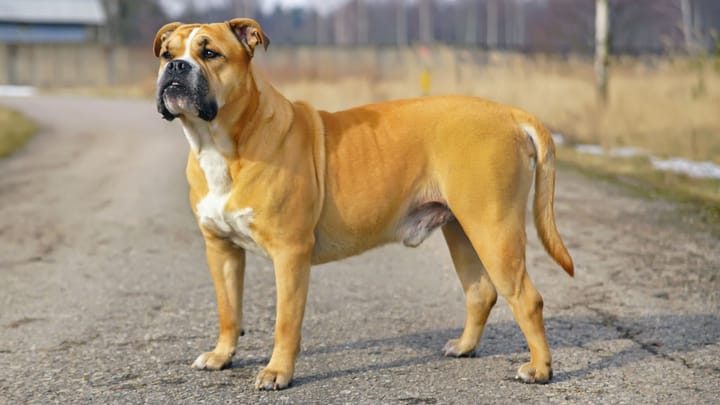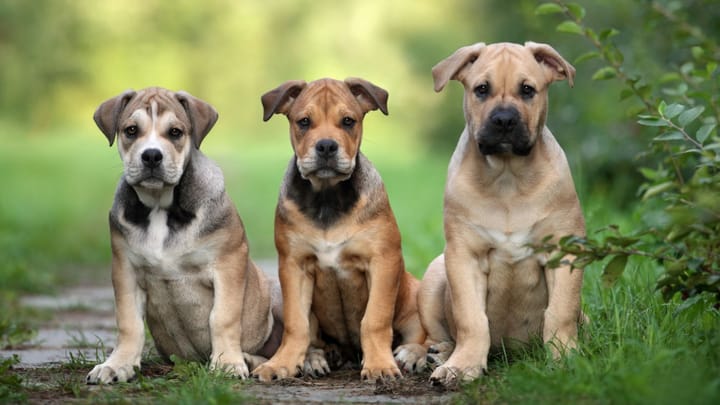Majorca Mastiff
Other names : Presa Mallorquin, Majorca Bulldog, Majorca Mastiff, Ca De Bou


The Ca De Bou, or the Majorcan Mastiff, is a stocky, extremely powerful breed that was developed near the Iberian Peninsula. Like all mastiffs, the Ca De Bou has large, muscular shoulders and a huge head. Unsurprisingly, these imposing looking animals were used as guard dogs in coastal settlements to ward off pirates and would be robbers. Despite their appearance, these dogs become very docile and quiet when not on duty. And as long as they receive the right training and socialisation, they make excellent family pets.
|
Life expectancy |
The Majorca Mastiff has a life expectancy of between 10 and 12 years |
|
Temperament |
|
|
Size |
Medium
|
|
Adult size |
Female
Between 20 and 22 in
Male
Between 22 and 23 in
|
|
Adult weight |
Female
Between 66 and 75 lb
Male
Between 77 and 84 lb
|
|
Coat colour
Brindle. Fawn. Black. Tan. Black. |
Black Brown Red Brindle |
|
Type of coat
Short. Flat. Rough. |
Short |
|
Eye colour
Dark. |
Brown
|
These dogs are very, very strong. Owners need to treat them with a firm but fair hand. Socialise as soon as possible. A poorly trained Mastiff can be extremely difficult to handle. Don’t let these powerful dogs get the better of you. They’re naturally obedient but they will also take advantage of passive owners.
More details about the Majorca Mastiff
Majorca Mastiff: Origins and history
Unfortunately, the earliest records of these dogs show that they were used in the Mediterranean as fighting dogs and bear baiters. Luckily, as these barbaric practices began to decline, the Ca de Bou found a new lease of life as a guard dog and a watchdog.
In the eighteenth century, when Mallorca became an English colony after the Treaty of Utrecht, the English began to cross their guard and combat dogs with the Great Iberian Mastiff, obtaining the Ca de Bou (also called the Perro in his country). In the Spanish Book of Origins of 1923, we already see the existence of this breed. The first subject was inscribed in 1928 and, in 1929, a copy of this dog won the Barcelona exhibition.
It was first registered by the FCI in 1964. The breed experienced a dip in numbers during the following decades but had a welcome resurgence in the late 1980s, becoming especially popular in Russian and Eastern Europe. The first Ca de Bous were introduced to the UK around 2001.
Physical characteristics of the Majorca Mastiff
The Majorca Mastiff is a medium-sized dog with a powerful grip. He has an elongated, muscular frame, with short but powerful legs. He has a thick neck and very large head with a stubby muzzle and small ears. The tail is fat at the base and narrows towards the tip, ending in a point. There’s a notable difference between the sexes; the males tend to be much larger.
FCI classification of the Majorca Mastiff
-
Group 2 - Pinscher and Schnauzer - Molossoid and Swiss Mountain and Cattledogs
-
Section 1 : Pinscher and Schnauzer type
Majorca Mastiff: Characteristics
Majorca Mastiff: Behaviour
Training a Majorca Mastiff
As long as you stick to the basics, this dog is fairly easy to train. Early socialisation is vital for big powerful dogs like the Ca de Bou.
Majorca Mastiff: Lifestyle
Breed compatibility Majorca Mastiff
Majorca Mastiff: Purchase price
We do not have enough data to set an average price. Looking after a dog of this size typically costs between £80 to £160 a month, including food, medical/insurance, and incidental expenses.
Majorca Mastiff: Grooming
The Ca de Bou requires minimal grooming. A quick brush once every few weeks is all he really needs.
Majorca Mastiff: Health
This is a well-bred and very healthy working dog with an average life expectancy of 11 years.
This breed is as sturdy and as tough as a dog can get. If well-looked after and not overstrained as puppies, they grow up to be strong, well-built, and very self-assured.
A shelter must be made available in the garden to protect against hot weather.
Big dogs rarely struggle with maintaining their body temperature during the colder months of the year.
The Ca de Bou isn’t the most active breed. Overfeeding him by even the smallest can lead to unwanted weight gain.
- Hip dysplasia
- Bloat








